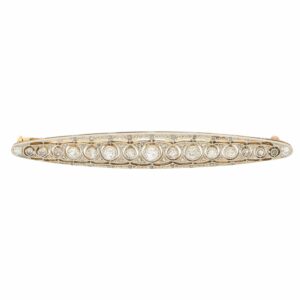Like the Georgian and Victorian eras before it, the Edwardian jewellery period derives its name from the reigning monarch of the time – in this case, English King Edward VII. This period ran from 1901-1910 and is the last jewellery era appellation to be defined by a British Monarch. The Edwardian period of jewellery is in fact considered to have begun earlier, during the ultimate years of Queen Victoria’s reign, and it ends a few years after King Edward’s death. Across the rest of Europe this movement was known as ‘La Belle Epoque’.
Upon his ascension to the throne, King Edward VII removed all reference to the previous Victorian reign and had Buckingham Palace completely renovated by the designers of the Ritz Hotel in the ostentatious fashion of the era. Edward wanted to rival the glamour of the courts of Germany and Russia, as well as large British stately homes and mansions of the Rothschilds.
King Edwards’ reign is often associated with the luxury lifestyle of the upper class where the King frequented parties and social gatherings. Jewellery was a hugely important part of displaying this extravagance. Machine made jewellery that has previously been viewed as fashionable and an innovation suddenly became out of fashion. Jewellery styles changed from being large to delicate and ethereal.
Jewellers of the time rejected the European wide Art Noveau and the Arts and Craft Movement and instead began to prefer traditional motifs, such as the garland, and used these as the basis of their more delicate and fluid designs.
Edwardian jewellery designs focused on diamond, pearl and platinum creations made by famous brands such as Cartier and Boucheron. These new designs which rejected the Art Noveau movement instead took inspiration from eighteenth century jewellery designs and in particular The Court of Versailles in Paris which was the inspiration of designs of more aristocratically styled pieces which became popular during the period.
Designers used ornamental motifs from earlier centuries and from 1850 pattern books of these pieces began to circulate among jewellery designers of the time. Diamond miner De Beers Consolidated Mines was founded in 1888 and the discovery of new diamond mines made the stone more affordable to designers and prompted the introduction of new gemstone cuts.
In 1902 Pierre Cartier opened his first shop in London on New Burlington Street in the West End. He is said to have encouraged his designers to walk the streets of Paris and use seventeenth and eighteenth century architecture for inspiration.
King Edward VII’s coronation in 1902 was a lavish event which prompted a hike in demand for diamond based pieces. Edward ordered 27 tiaras from Cartier for the occasion. Following the event other jewellers of the period Aspery, Carrington and Garrad became overwhelmed with orders for diamond pieces for customers to display their material wealth at Royal balls and soirées.
In 1904 Cartier became the official jewellery supplier to King Edward VII and designed some of the most innovative pieces of the era. Edward referred to Cartier as “the jeweller of kings and the king of jewellers”. The designer stood out as being at the fore front of fashion trends and was willing to experiment with new materials like platinum.
Some of Cartier’s most famous Edwardian pieces include an elongated double pendant necklace called ‘the Lavalier’, which was named after the French theatre actress Ève Lavallière. Designer Boucheron designed its own signature piece which was a necklace of strung pearls separated by diamond rondelles designed by Paul LeGrand.
Following Cartier’s designs the use of platinum as a more durable material than gold and silver became a popular choice. This led to the creation of the ‘invisible setting’ design where diamonds looked as if they were floating in the air, or on the skin, fitting in with the overall style preference of the time for a more delicate and elegant look.
Pearls were more valuable than diamonds at the time, making the size and quantity of your pearls just as important as a diamond ring as a declaration of your wealth. Women favoured bejewelled headpieces like tiaras and bandeaus. Another popular piece which is said to have been directly inspired by Queen Alexandra were dog collars. These first appeared in the Victorian era and typically consisted of a either a ribbon decorated with a brooch, a gemstone or many strands of pearls strung closely together.
The new Duchess of Marlborough, born a Vanderbilt, and other nobility and nouveau riche of the time were all competing to look more splendid than the other. It was during this time that Mary Princess of Wales, who later became Queen Mary, developed her own personal style motto: “One can never wear too many diamonds.”
The glamour and frivolity of the Edwardian period came to a dramatic halt in 1914 with the beginning of World War I. In the run up to war, platinum became a sparse material and was no longer able to be used in jewellery designs. White-gold alloy was used instead as an affordable alternative which reduced the cost of pieces. Regardless, as the war gripped the nation, priorities shifted from tiaras and soirées to the war effort.



